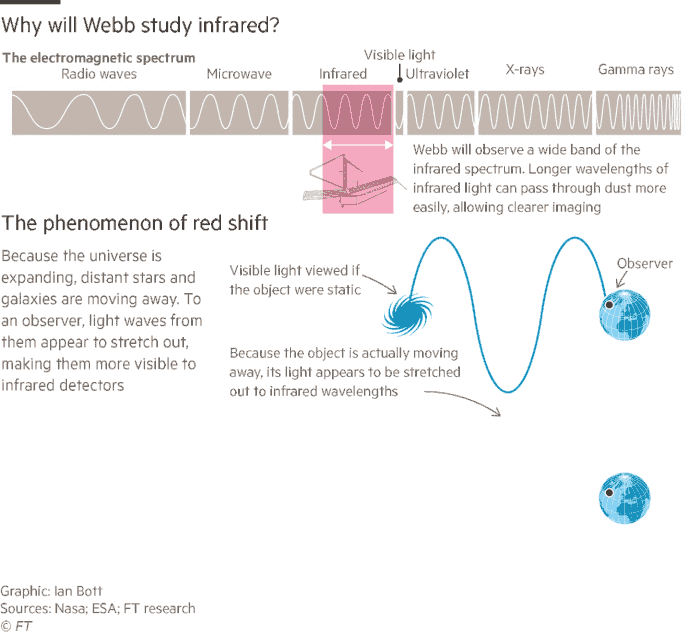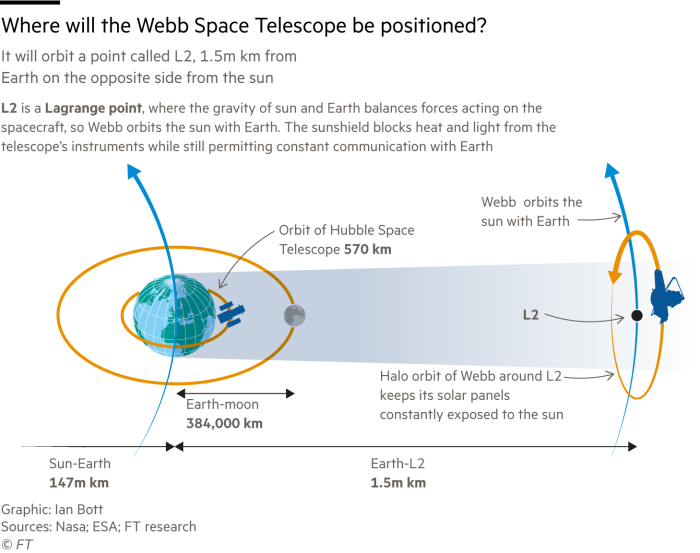The most ambitious and costly telescope ever built was fired into space on Christmas Day, with the aim of seeing deeper into space — and therefore further back in time — than ever before.
After three decades of planning and construction beset by several delays and escalating costs, the $10bn James Webb Space Telescope is finally on its way to a special orbit, four times further from Earth than the Moon.
One of the main aims is to take images of the very first stars and galaxies that formed from primordial gas in the “cosmic dawn” about 200m years after the Big Bang.
But astronomers also expect the Webb telescope to provide a treasure trove of observations of objects closer to home, particularly planets — both in our own solar system and those orbiting stars elsewhere in the galaxy. Its instruments will measure the chemical composition of these planetary atmospheres, looking for molecular building blocks of life.
Richard Ellis, professor of astrophysics at University College London, has been involved in the project since the early 1990s, when the US space agency Nasa put together a scientific team to plan a successor to the recently launched Hubble observatory. It was named James Webb after the Nasa director who led the Apollo programme during the 1960s. The European and Canadian space agencies joined as junior partners in the US-led project.
“It became very expensive, there were a lot of delays and Webb was threatened with cancellation several times,” said Ellis. “But now, at last, we have a telescope that astronomers are very excited about and proud of.”
Webb’s 6.5 metre primary mirror makes it 100 times more powerful than Hubble. But the main difference between the two great telescopes is that Hubble observes visible light, while Webb operates in the infrared region. The latter is far better for detecting extremely distant objects because their light is shifted to longer wavelengths by the expansion of the universe.
Whereas Hubble is in a low orbit just 550km above Earth, Webb will be 1.5m km away at the “second Lagrange point”, or L2. Here, gravity from the Sun and Earth exactly balance the orbital motion of a satellite, so it appears to hover in the same place in space.
The advantage of L2 over low Earth orbit is that its great distance from the planet makes it much easier to keep Webb cool and avoids interference from Earth’s own infrared radiation. One disadvantage is that it is too far to reach by a maintenance and repair mission should something go wrong. Hubble was famously rescued from ignominy in 1993, when Shuttle astronauts installed corrective optics on its faulty mirror.


Webb will take about a month to reach L2 after its launch by Europe’s Ariane 5 rocket. On the way, it will unfold its primary mirror, which is made of 18 hexagonal plates of gold-coated beryllium metal, and a giant sunshield, which is the size of a tennis court and will keep the telescope in perpetual shadow at an expected temperature of -233C.
But even that is not cold enough for one of Webb’s four instruments, the mid-infrared instrument, or MIRI. It will be taken down to -266C, just seven degrees above absolute zero, with a cryocooler. “It works on the same principle as your domestic fridge, except that the coolant is helium, which is liquid at extremely low temperatures,” said Gillian Wright, director of the UK Astronomy Technology Centre in Edinburgh and co-leader of the MIRI team.
MIRI will play a key role both in detecting the first glimmers of starlight through thick clouds of primordial gas during the cosmic dawn and in analysing the atmospheres of distant planets. But when asked what observations she was most looking forward to, Wright replied: “I’m most excited about finding something that is a complete surprise. We’ve never had a mid-infrared instrument like MIRI in space before and it will find things that we just don’t know about now.”
Wright added that Webb and its instruments would begin operating with a series of commissioning observations during April and May to check that everything was working well. Astronomy research will then start around July.


The Space Telescope Science Institute in Baltimore has been allocating observing time to astronomers on Hubble for 30 years and will do the same for Webb. Slots are heavily oversubscribed so a peer-review system is used to decide who should obtain them, with some reserved for scientists involved in building instruments for the telescope.
Wright said her team would intensively examine a small patch of sky that Hubble had already studied called the Hubble Deep Field to look for ultra-faint and extremely early galaxies. “We also have a big programme looking at the atmosphere of planets,” she said. Another question that scientists want to answer is how exoplanets — orbiting stars elsewhere in our galaxy — form from cosmic dust.
Although the Christmas Day launch from Kourou, French Guiana, went perfectly, astronomers must first endure what Ellis called an “anguishing few months” after waiting for Webb to complete its complex series of unfurlings and instrument commissioning exercises.
If the telescope comes through in good working order, it promises huge scientific dividends — an astronomical Christmas present that should last for a decade.
“I have been working on the early evolution of galaxies for many years,” said Ellis. “To glimpse the ‘cosmic dawn’ with Webb will be the culmination of my career.”
Credit: Source link















